fuel FIAT STRADA 2012 Owner handbook (in English)
[x] Cancel search | Manufacturer: FIAT, Model Year: 2012, Model line: STRADA, Model: FIAT STRADA 2012Pages: 187, PDF Size: 8.06 MB
Page 54 of 187
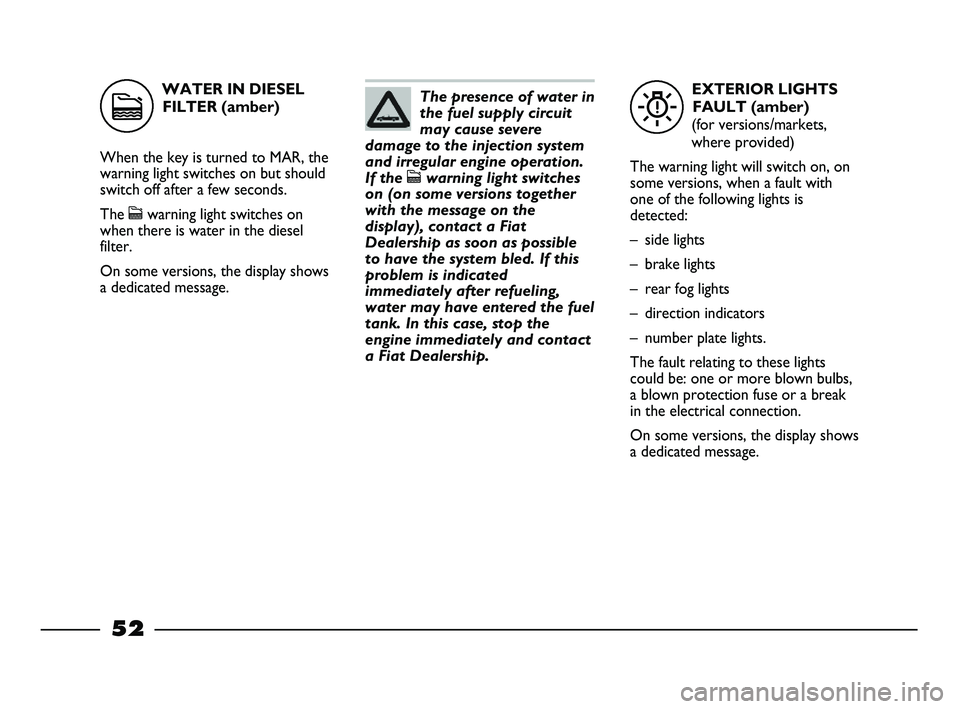
EXTERIOR LIGHTS
FAULT (amber)
(for versions/markets,
where provided)
The warning light will switch on, on
some versions, when a fault with
one of the following lights is
detected:
– side lights
– brake lights
– rear fog lights
– direction indicators
– number plate lights.
The fault relating to these lights
could be: one or more blown bulbs,
a blown protection fuse or a break
in the electrical connection.
On some versions, the display shows
a dedicated message.The presence of water in
the fuel supply circuit
may cause severe
damage to the injection system
and irregular engine operation.
If the
cwarning light switches
on (on some versions together
with the message on the
display), contact a Fiat
Dealership as soon as possible
to have the system bled. If this
problem is indicated
immediately after refueling,
water may have entered the fuel
tank. In this case, stop the
engine immediately and contact
a Fiat Dealership.
W
WATER IN DIESEL
FILTER (amber)
When the key is turned to MAR, the
warning light switches on but should
switch off after a few seconds.
The cwarning light switches on
when there is water in the diesel
filter.
On some versions, the display shows
a dedicated message.
c
52
045-094 STRADA LUM GB 1ed 23-01-2012 9:10 Pagina 52
Page 55 of 187
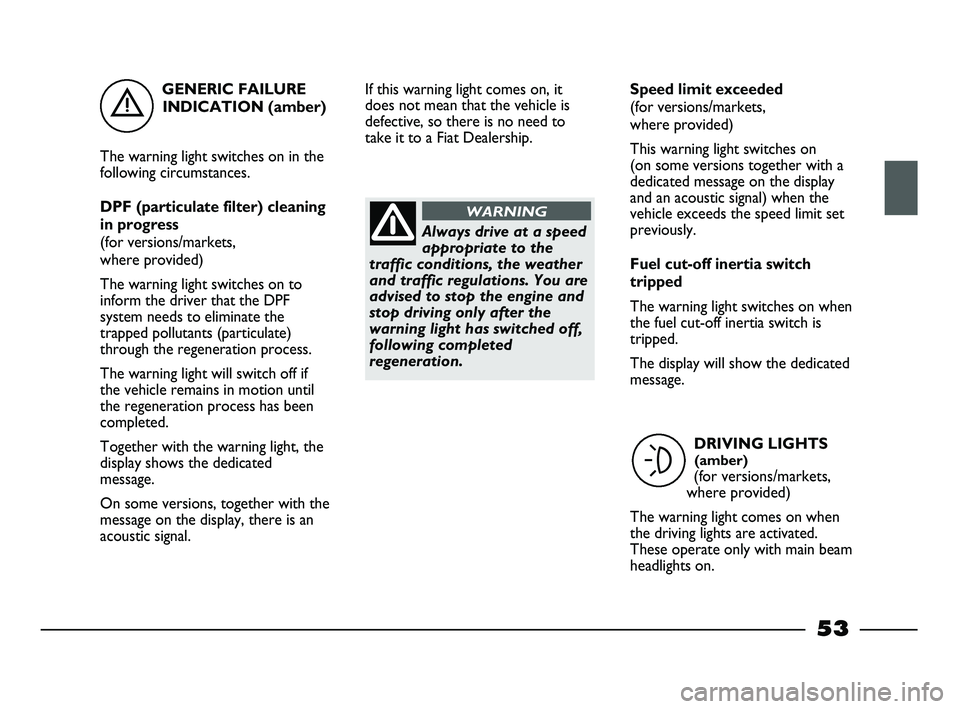
GENERIC FAILURE
INDICATION (amber)
The warning light switches on in the
following circumstances.
DPF (particulate filter) cleaning
in progress
(for versions/markets,
where provided)
The warning light switches on to
inform the driver that the DPF
system needs to eliminate the
trapped pollutants (particulate)
through the regeneration process.
The warning light will switch off if
the vehicle remains in motion until
the regeneration process has been
completed.
Together with the warning light, the
display shows the dedicated
message.
On some versions, together with the
message on the display, there is an
acoustic signal. If this warning light comes on, it
does not mean that the vehicle is
defective, so there is no need to
take it to a Fiat Dealership.Speed limit exceeded
(for versions/markets,
where provided)
This warning light switches on
(on some versions together with a
dedicated message on the display
and an acoustic signal) when the
vehicle exceeds the speed limit set
previously.
Fuel cut-off inertia switch
tripped
The warning light switches on when
the fuel cut-off inertia switch is
tripped.
The display will show the dedicated
message.
è
53
Always drive at a speed
appropriate to the
traffic conditions, the weather
and traffic regulations. You are
advised to stop the engine and
stop driving only after the
warning light has switched off,
following completed
regeneration.
WARNING
DRIVING LIGHTS
(amber)
(for versions/markets,
where provided)
The warning light comes on when
the driving lights are activated.
These operate only with main beam
headlights on.„
045-094 STRADA LUM GB 1ed 23-01-2012 9:10 Pagina 53
Page 67 of 187

FUEL CUT-OFF
SWITCH fig. 66
This is a safety switch that is tripped
in the event of impact, cutting off the
fuel supply, thereby causing the
engine to stop.
fig. 66
F0X0042m
fig. 67
F0X0043m
If, after a collision, you
smell fuel or notice
leaks from the fuel system, do
not reset the switch to avoid
the risk of fire.
WARNING
INTERNAL FEATURES
GLOVE COMPARTMENT
fig. 67
To open, pull grip A. On some
versions, when the glove
compartment opens the internal
lighting switches on. Some versions
feature an upper compartment. To
open press button B. If no fuel leaks are detected and the
vehicle can be started again, press
button A to reactivate the fuel
system.
After a collision, remember to turn
the ignition key to STOP to prevent
battery from running down.
Do not travel with the
glove box open: it could
injure the passenger in the
event of an accident.
WARNING
65
045-094 STRADA LUM GB 1ed 23-01-2012 9:10 Pagina 65
Page 76 of 187
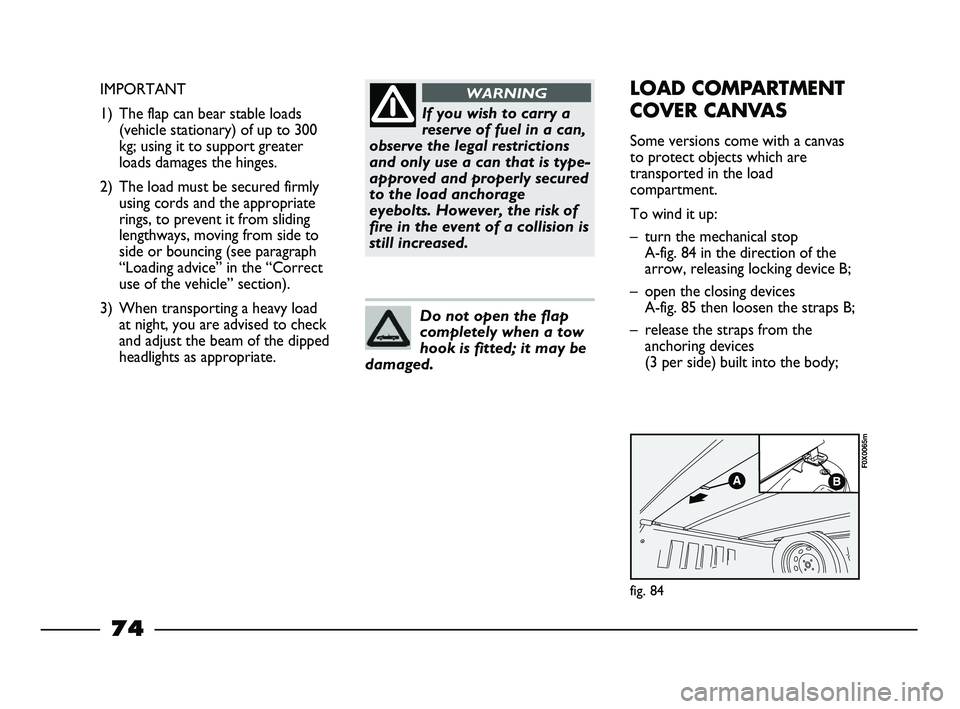
If you wish to carry a
reserve of fuel in a can,
observe the legal restrictions
and only use a can that is type-
approved and properly secured
to the load anchorage
eyebolts. However, the risk of
fire in the event of a collision is
still increased.
WARNINGIMPORTANT
1) The flap can bear stable loads
(vehicle stationary) of up to 300
kg; using it to support greater
loads damages the hinges.
2) The load must be secured firmly
using cords and the appropriate
rings, to prevent it from sliding
lengthways, moving from side to
side or bouncing (see paragraph
“Loading advice” in the “Correct
use of the vehicle” section).
3) When transporting a heavy load
at night, you are advised to check
and adjust the beam of the dipped
headlights as appropriate.
Do not open the flap
completely when a tow
hook is fitted; it may be
damaged.
LOAD COMPARTMENT
COVER CANVAS
Some versions come with a canvas
to protect objects which are
transported in the load
compartment.
To wind it up:
– turn the mechanical stop
A-fig. 84 in the direction of the
arrow, releasing locking device B;
– open the closing devices
A-fig. 85 then loosen the straps B;
– release the straps from the
anchoring devices
(3 per side) built into the body;
fig. 84
F0X0065m
74
045-094 STRADA LUM GB 1ed 23-01-2012 9:10 Pagina 74
Page 80 of 187
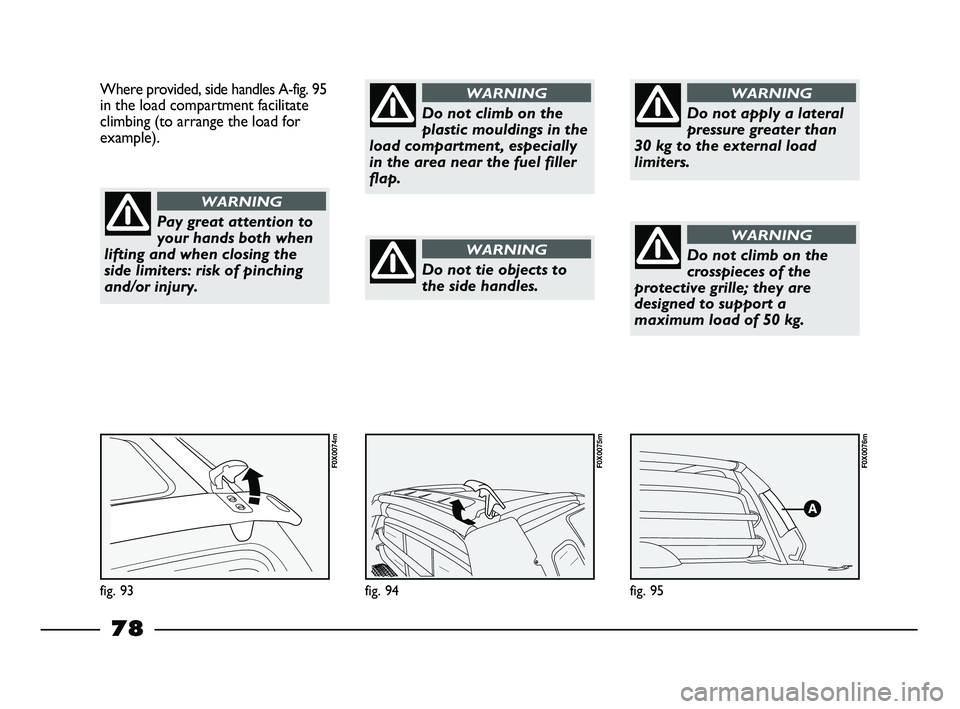
fig. 95
F0X0076m
fig. 94
F0X0075m
Where provided, side handles A-fig. 95
in the load compartment facilitate
climbing (to arrange the load for
example).
fig. 93
F0X0074m
Pay great attention to
your hands both when
lifting and when closing the
side limiters: risk of pinching
and/or injury.
WARNING
Do not climb on the
plastic mouldings in the
load compartment, especially
in the area near the fuel filler
flap.
WARNING
Do not tie objects to
the side handles.
WARNING
Do not apply a lateral
pressure greater than
30 kg to the external load
limiters.
WARNING
Do not climb on the
crosspieces of the
protective grille; they are
designed to support a
maximum load of 50 kg.
WARNING
78
045-094 STRADA LUM GB 1ed 23-01-2012 9:10 Pagina 78
Page 94 of 187

RADIO TRANSMITTERS AND
MOBILE PHONES
Radio transmitters (car phones, CB
radios etc.) cannot be used inside
the vehicle unless a separate aerial is
mounted externally.
IMPORTANT The use of such
devices inside the passenger
compartment (without an external
aerial) may, in addition to potential
damage to the health of the
passengers, cause malfunctions in the
vehicle’s electronic systems,
compromising the safety of the
vehicle.
In addition, transmission and
reception of these devices may be
adversely affected by the shielding
effect of the vehicle’s body.
As far as the use of EC-approved
mobile phones is concerned (GSM,
GPRS, UMTS), follow the usage
instructions provided by the mobile
phone manufacturer.REFUELLING
Never introduce even a
minimal quantity of
petrol to the tank, even
in an emergency; the catalytic
converter would be damaged,
irreparably compromising its
operation.
An inefficient catalytic
converter leads to
harmful exhaust
emissions, thus contributing to
environmental pollution.
The vehicle must be
refuelled exclusively
with diesel for motor
vehicles in compliance with
European specification EN590.
The use of other products or
mixtures may damage the
engine beyond repair and
consequently invalidate the
warranty, due to the damage
caused. If you accidentally
refuel with another type of fuel,
do not start the engine, and
drain the tank. If the engine has
run, even for a very short time,
with other fuels, the whole fuel
circuit must be drained in
addition to the tank.
92
045-094 STRADA LUM GB 1ed 23-01-2012 9:10 Pagina 92
Page 95 of 187
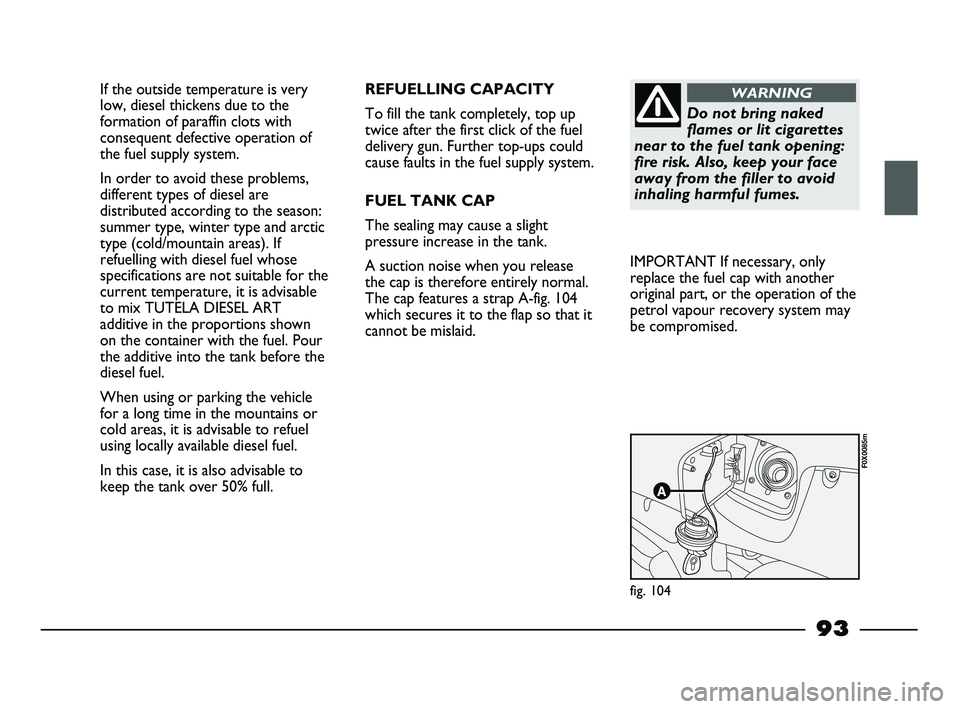
If the outside temperature is very
low, diesel thickens due to the
formation of paraffin clots with
consequent defective operation of
the fuel supply system.
In order to avoid these problems,
different types of diesel are
distributed according to the season:
summer type, winter type and arctic
type (cold/mountain areas). If
refuelling with diesel fuel whose
specifications are not suitable for the
current temperature, it is advisable
to mix TUTELA DIESEL ART
additive in the proportions shown
on the container with the fuel. Pour
the additive into the tank before the
diesel fuel.
When using or parking the vehicle
for a long time in the mountains or
cold areas, it is advisable to refuel
using locally available diesel fuel.
In this case, it is also advisable to
keep the tank over 50% full.REFUELLING CAPACITY
To fill the tank completely, top up
twice after the first click of the fuel
delivery gun. Further top-ups could
cause faults in the fuel supply system.
FUEL TANK CAP
The sealing may cause a slight
pressure increase in the tank.
A suction noise when you release
the cap is therefore entirely normal.
The cap features a strap A-fig. 104
which secures it to the flap so that it
cannot be mislaid.
fig. 104
F0X0085m
Do not bring naked
flames or lit cigarettes
near to the fuel tank opening:
fire risk. Also, keep your face
away from the filler to avoid
inhaling harmful fumes.
WARNING
IMPORTANT If necessary, only
replace the fuel cap with another
original part, or the operation of the
petrol vapour recovery system may
be compromised.
93
045-094 STRADA LUM GB 1ed 23-01-2012 9:10 Pagina 93
Page 99 of 187
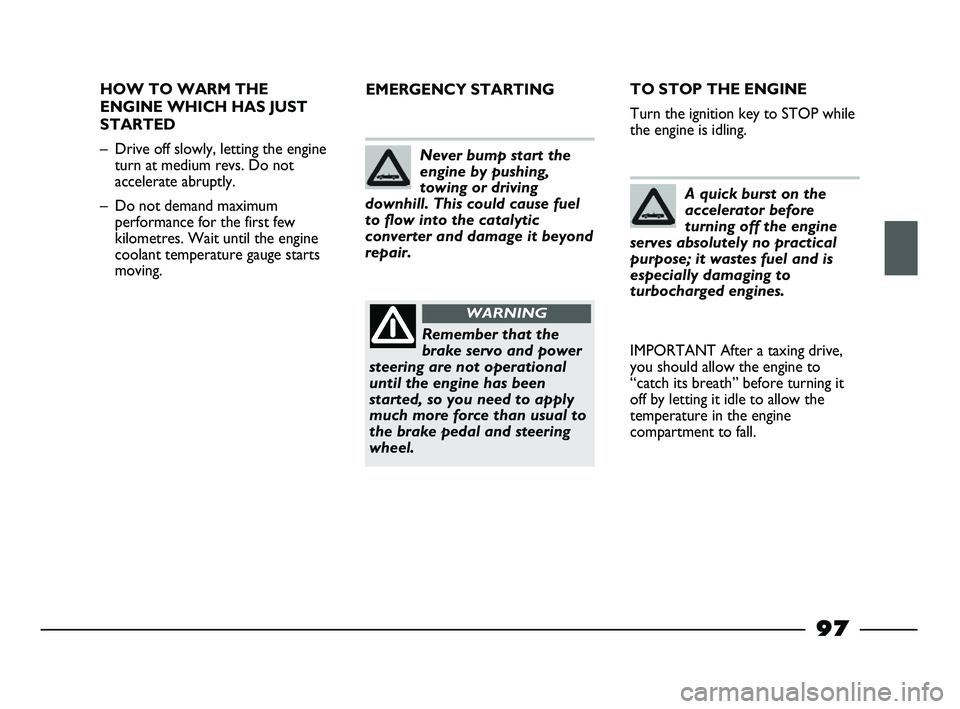
97
HOW TO WARM THE
ENGINE WHICH HAS JUST
STARTED
– Drive off slowly, letting the engine
turn at medium revs. Do not
accelerate abruptly.
– Do not demand maximum
performance for the first few
kilometres. Wait until the engine
coolant temperature gauge starts
moving.EMERGENCY STARTING
Never bump start the
engine by pushing,
towing or driving
downhill. This could cause fuel
to flow into the catalytic
converter and damage it beyond
repair.
Remember that the
brake servo and power
steering are not operational
until the engine has been
started, so you need to apply
much more force than usual to
the brake pedal and steering
wheel.
WARNING
TO STOP THE ENGINE
Turn the ignition key to STOP while
the engine is idling.
A quick burst on the
accelerator before
turning off the engine
serves absolutely no practical
purpose; it wastes fuel and is
especially damaging to
turbocharged engines.
IMPORTANT After a taxing drive,
you should allow the engine to
“catch its breath” before turning it
off by letting it idle to allow the
temperature in the engine
compartment to fall.
095-106 STRADA LUM GB 1ed 9-01-2012 14:51 Pagina 97
Page 104 of 187
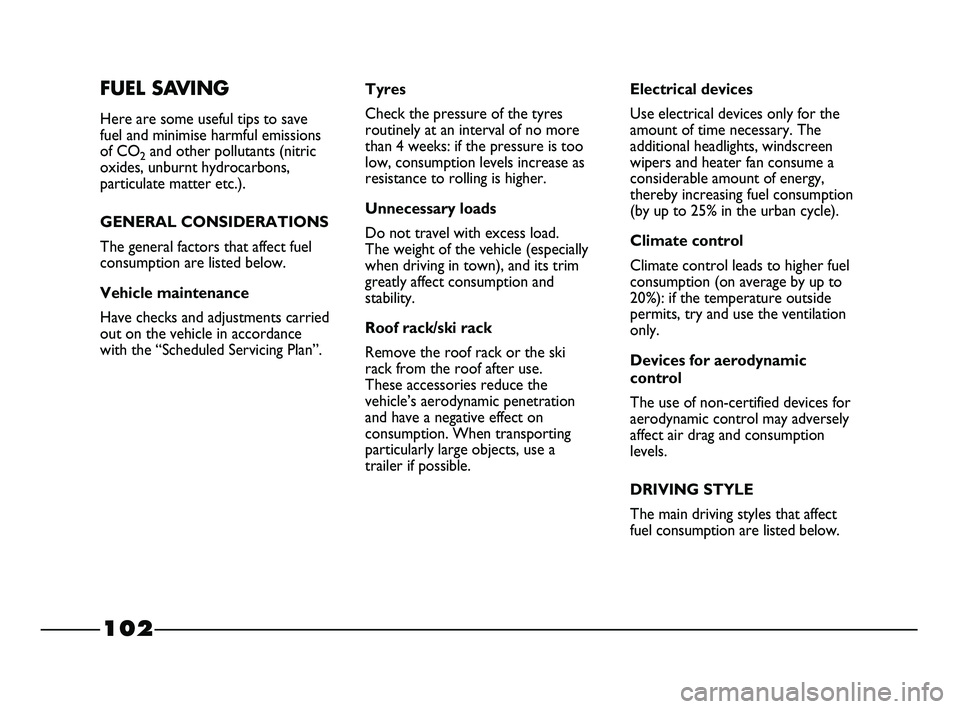
102
FUEL SAVING
Here are some useful tips to save
fuel and minimise harmful emissions
of CO
2and other pollutants (nitric
oxides, unburnt hydrocarbons,
particulate matter etc.).
GENERAL CONSIDERATIONS
The general factors that affect fuel
consumption are listed below.
Vehicle maintenance
Have checks and adjustments carried
out on the vehicle in accordance
with the “Scheduled Servicing Plan”.Tyres
Check the pressure of the tyres
routinely at an interval of no more
than 4 weeks: if the pressure is too
low, consumption levels increase as
resistance to rolling is higher.
Unnecessary loads
Do not travel with excess load.
The weight of the vehicle (especially
when driving in town), and its trim
greatly affect consumption and
stability.
Roof rack/ski rack
Remove the roof rack or the ski
rack from the roof after use.
These accessories reduce the
vehicle’s aerodynamic penetration
and have a negative effect on
consumption. When transporting
particularly large objects, use a
trailer if possible.Electrical devices
Use electrical devices only for the
amount of time necessary. The
additional headlights, windscreen
wipers and heater fan consume a
considerable amount of energy,
thereby increasing fuel consumption
(by up to 25% in the urban cycle).
Climate control
Climate control leads to higher fuel
consumption (on average by up to
20%): if the temperature outside
permits, try and use the ventilation
only.
Devices for aerodynamic
control
The use of non-certified devices for
aerodynamic control may adversely
affect air drag and consumption
levels.
DRIVING STYLE
The main driving styles that affect
fuel consumption are listed below.
095-106 STRADA LUM GB 1ed 9-01-2012 14:51 Pagina 102
Page 105 of 187

103
Starting
Do not warm up the engine at low
or high revs when the vehicle is
stationary; this causes the engine to
warm up more slowly, thereby
increasing fuel consumption and
emissions. It is advisable to move off
immediately and slowly, avoiding
high speeds: in this way the engine
will warm up more quickly.
Unnecessary actions
Avoid accelerating when stopped at
traffic lights or before stopping the
engine.
This, as well as double declutching, is
absolutely unnecessary and increases
consumption and pollution.
Gear selection
As soon as the conditions of the
traffic and road permit, use a higher
gear.
Using a low gear for faster
acceleration will increase
consumption.Improper use of a high gear
increases consumption, emissions
and engine wear.
Maximum speed
Fuel consumption increases
considerably with speed. Maintain a
constant speed, avoiding
unnecessary braking and
acceleration, which cost in terms of
both fuel and emissions.
Acceleration
Accelerating violently will greatly
affect consumption and emissions:
acceleration should be gradual.
CONDITIONS OF USE
The main usage conditions that
negatively affect fuel consumption
are listed below.Cold starting
Short journeys and frequent cold
starts do not allow the engine to
reach optimum operating
temperature.
This results in a significant increase
in consumption levels (by 15–30% in
the urban cycle) and emissions.
Traffic and road conditions
Rather high consumption levels are
linked to situations with heavy
traffic, for instance when travelling in
queues with frequent use of the
lower gears or in cities with many
traffic lights. Winding mountain
roads and rough road surfaces also
adversely affect consumption.
Stopping in traffic
During prolonged hold-ups
(e.g. at level crossings) the engine
should be switched off.
095-106 STRADA LUM GB 1ed 9-01-2012 14:51 Pagina 103